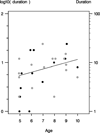Cantharidin for the treatment of molluscum contagiosum: a prospective, double-blinded, placebo-controlled trial
- PMID: 22897595
- PMCID: PMC3502651
- DOI: 10.1111/j.1525-1470.2012.01810.x
Cantharidin for the treatment of molluscum contagiosum: a prospective, double-blinded, placebo-controlled trial
Abstract
Our aim was to study the effects and safety of cantharidin in the treatment of molluscum contagiosum (MC), we conducted a prospective, double-blinded, placebo-controlled, randomized clinical trial to evaluate the safety and efficacy of topical cantharidin for treatment of pediatric MC in an academic ambulatory care center. Twenty-nine children aged 5-10 with a diagnosis of MC were enrolled to receive treatment with cantharidin or placebo. The main outcome measure was complete clearance of all molluscum lesions. In contrast to previous retrospective observational studies, the performance of cantharidin treatment over 2 months was not substantially better than the performance of placebo. The scope of follow-up was limited to five visits over 2 months of treatment. A longer follow-up period might have captured a greater effect of cantharidin. Over a 2 month period, the magnitude of the cantharidin treatment effects in the target population are, at best, not large. This study provided objective unbiased estimates of the magnitude of cantharidin treatment effects and provided important prospective safety data. Our subjects experienced minimal side effects when treated with cantharidin.
© 2012 Wiley Periodicals, Inc.
Conflict of interest statement
There are no conflicts of interest to state for any of the authors.
Figures





Comment in
-
The utility of cantharidin for the treatment of molluscum contagiosum.Pediatr Dermatol. 2015 Mar-Apr;32(2):295. doi: 10.1111/pde.12518. Epub 2015 Feb 18. Pediatr Dermatol. 2015. PMID: 25690255 No abstract available.
-
Cantharidin response.Pediatr Dermatol. 2015 Mar-Apr;32(2):295-6. doi: 10.1111/pde.12590. Pediatr Dermatol. 2015. PMID: 25801081 No abstract available.
References
-
- Silverberg NB. Pediatric Molluscum Contagiosum; Optimal treatment strategies. Pediatr Drugs. 2003;5(8):505–512. - PubMed
-
- Kakourou T, Zachariades A, Anastasiou T, et al. Molluscum contagiosum in Greek children: a case series. Int J Dermatol. 2005;44:221–223. - PubMed
-
- Silverberg NB, Sidbury R, Mancini AJ. Childhood molluscum contagiosum: Experience with cantharidin therapy in 300 patients. J Am Acad Dermatol. 2000;43:503–507. - PubMed
-
- Leslie KS, Dootson G, Sterling JC. Topical salicylic acid gel as treatment for molluscum contagiosum in children. J of Dermatol Treatment. 2005;16:336–340. - PubMed
-
- Short KA, Fuller CF, Higgins EM. Double-blind, randomized, placebo-controlled trial of the use of topical 10% potassium hydroxide solution in the treatment of molluscum contagiosum. Pediatr Dermatol. 2006;23(3):279–281. - PubMed
Publication types
MeSH terms
Substances
Grants and funding
LinkOut - more resources
Full Text Sources

